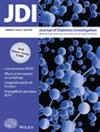A prediction model for diabetes complications using the Kokuho Database and its application to public health services in Japan
Abstract
Aims/Introduction
This study aimed to improve efficiency of participant selection in Japan's Specific Health Guidance (SHG) program by developing a model to predict 3-year risk of diabetes complications. The targeted complications included macrovascular diseases (ischemic heart disease and cerebrovascular disease), microvascular diseases (diabetic nephropathy, diabetic neuropathy, diabetic retinopathy), and chronic kidney disease (CKD).
Materials and Methods
We utilized the Kokuho Database to analyze individuals in Saga Prefecture who underwent Specific Health Checkups from 2016 to 2019 without diabetes complications at baseline. To evaluate risk of the complications across all examinees, we excluded medicated individuals ineligible for SHG, while including those without diabetes in the prediction cohort. The outcomes of diabetes complications were derived from claims data. Explanatory variables included health checkup results, questionnaire responses, medical diagnoses, and prescription records. The predictive model was constructed using logistic regression, and its performance was evaluated using the Area Under the Curve (AUC) from fivefold cross-validation.
Results
Through model optimization techniques, including stratification, the incorporation of quadratic terms, and variable selection, the AUC exceeded 0.7 for all conditions. Notably, the AUC for microvascular complications and CKD surpassed 0.8, indicating high predictive accuracy. The model identified a higher risk among individuals who met the health guidance criteria established by the Ministry of Health, Labour and Welfare, demonstrating alignment with existing standards.
Conclusions
This predictive model has potential to enhance the targeting process for health guidance in Japan, enabling more timely medical intervention. Its implementation could significantly contribute to the prevention of severe diabetes complications through earlier detection and treatment.


 求助内容:
求助内容: 应助结果提醒方式:
应助结果提醒方式:


